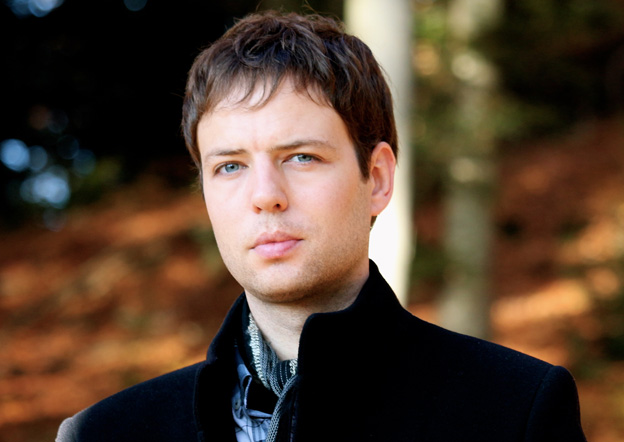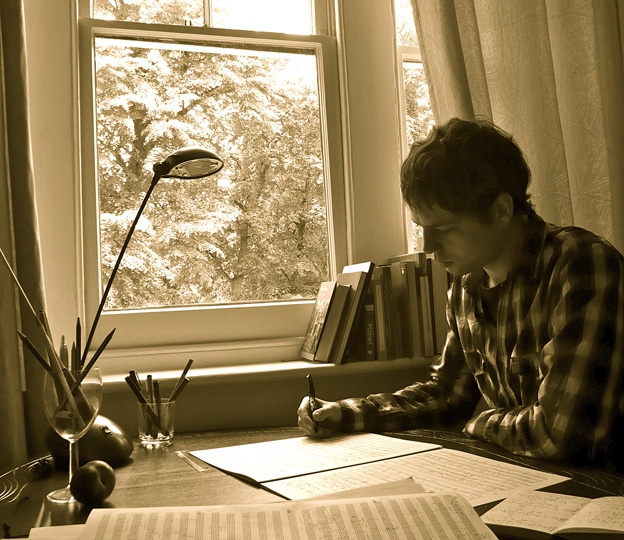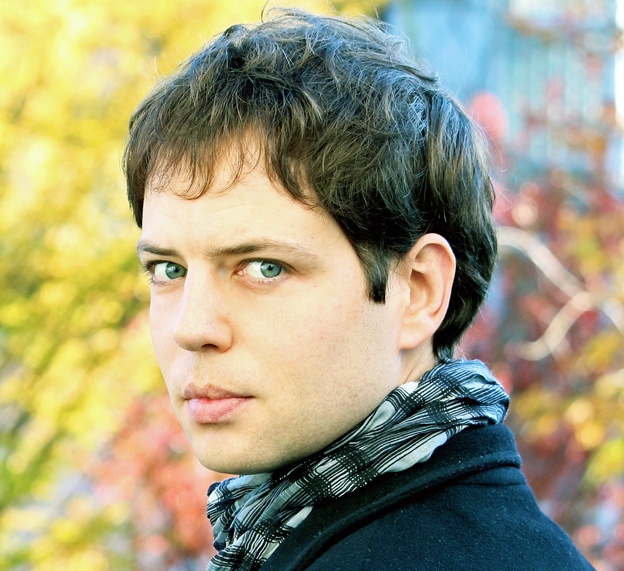How does one become a composer today?
In reality, I never thought about being a composer. In my case it was completely irrational. I remember perfectly the first time I wanted to compose something. I was tired of hearing the same thing from my Walkman and I chose to record something created by myself with instruments that I could play. I must have been about fifteen years old. It was a way to make the music I wanted to hear. And that’s, in a way, what I’m still doing today. Obviously that piece was a disaster, but it was an attempt.
You played the trombone, and I think Christian Lindberg was your idol.
My father took me to see him play at the Palau de la Musica in Valencia when I was twelve years old. Lindberg played as a soloist a work for alto trombone by Wagenseil or Albrechtberger with the Valencia Orchestra. And that was the first time I heard an orchestra live. But I remember that Lindberg played as an encore a piece entitled Bocetos de la Mancha, by Jan Sandström. That showed me that there was another way to make music. And I became also interested in Cage’s music.
I understand you also like to paint.
Yes, my father had a small frame shop. I grew up surrounded by paintings. Today I make a painting every time I compose a work. Sometimes I don’t know if I’m composing or painting, because I don’t see much difference between painting and composing. Even the process of composing is similar for me to painting. Instead of focusing on a fragment, and refining it with oil, what I do is a quick sketch with charcoal, then add a watercolour, then a more refined colour and finally I focus on the final touches before finishing the work. In composition I do practically the same thing. I usually compose very quickly, because I have the feeling that the final result will be more organic, more fluid and will have a more convincing rhetoric. But I don’t think I am inventing anything new.
Let’s talk about your work. Your first commission was a Double Brass Quintet that premiered in 2005 at New York’s Avery Fischer Hall.
It was a simple compositional exercise that has a more personal than a professional meaning, as it was based on improvisations for my grandfather, who had just passed away at the time. By a series of coincidences, the work ended up as a Double Brass Quintet in New York, for Canadian Brass and members of the New York Philharmonic, although I didn’t even go to the premiere.
Then came Aqua Cinereus in 2006.
I wrote that work for Cristobal Soler and the Philharmonic Orchestra of the University of Valencia where he played the trombone. It wasn’t very successful, but I sent a recording to Thomas Adès and he invited me to study with him in London. It was really the beginning, although in those years I wrote other compositions that allowed me to win some competitions and go to study in Madrid.
Which works did you start working with Thomas Adès in London?
I was supposed to stay in London only for one year, but I received some commissions and I was able to stay. The first composition on that I worked with Adès was the overture Hidd’n Blue (2009-11), commissioned by the London Symphony, a month after my arrival in London. It was premiered by François-Xavier Roth and has had a lot of international repercussion thanks to Gustavo Gimeno. Then I wrote Piedras (2009-10) for the Los Angeles Philharmonic, although its origin is also related to a class with Magnus Lindberg in Aldeburgh, who proposed that title to me.
In 2013 I wrote my first opera, Café Kafka, which is now absorbed in the second. I didn’t plan to write an opera, because I didn’t know that world very well. Actually, Café Kafka is a short opera. It was a commission from the manager of the London Sinfonietta to which several theatres and festivals were added. But thanks to this work I got into opera and now I’m writing the second one for the 2020-21 season of the Royal Opera House in London, which will have a normal duration. I’m back with Meredith Oakes as a librettist and it’s based on Dostoyevsky’s The Dream of a Ridiculous Man.
I see that is a recurrent theme in your work.
Surrealism is something that I consider part of me. I don’t feel like a surrealist composer, but I have used Breton’s automatic writing technique to compose Piedras. I am interested in many aspects of surrealism.
Another recurrent element is sociology, with allusions to hypermodernity in several of your compositions.
When I finished high school, I became interested in sociology and Lipovetsky, whose games of opposites attracted me quite a lot as a composer. Based on his hypermodernity I wrote a series of preludes for violin solo which I called Hyperludies (2014). I have also used Zygmunt Bauman’s famous concept of liquid society in my work Liquid Symetries (2013).
The oneiric and the sociological come together in your symphony Mural (2013-15).
Perhaps it is the composition that best agglutinates my first decade. It even quotes Tomas Luis de Victoria. Mural begins with a surrealist presentation and I use my Hyperlude III for solo violin, in the second movement, as a reflection of the current frenetic rhythm. Indeed, in the fourth I include some details of the introit from Victoria’s Requiem in the manner of ruins and as a sample of contemporary decadence. That use is related to Picasso’s famous phrase about copying and stealing. I didn’t really understand that phrase until 2013, when I composed Four Iberian Miniatures and ‘stole’ two bars of Lorca’s Anda Jaleo. I digested and vomited them, transformed into something different.
Let’s talk about the influence of flamenco in your work.
I discovered flamenco by rebelliousness towards a solfeggio teacher. I instinctively related it to the use of popular music as did Bartok or Ligeti. But I didn’t manage to integrate it into my work until the Four Iberian Miniatures. Then I used it again in my Concerto grosso (2016), which I wrote for the twentieth anniversary of the Casals Quartet with the National Orchestra of Spain. And again, in Turia (2017), for solo guitar and ensemble, perhaps my most flamenco-coloured work, although it is a transfigured flamenco mixed with very different aspects.
Turia is perhaps your most Valencian composition.
I have been away from Valencia for eleven years and only in 2017 I have I been able to write a work like Turia in homage to an almost surrealist river, which has no water. You walk through it, it has gardens and even an opera house. Anyway, the work is a tribute to the light of Valencia, like Joaquín Sorolla y Bastida painted it, and that I wanted to capture in my music.
And what about your latest works?
In July 2018, Patricia Kopatchinskaja and Sol Gabetta created a duo for violin and cello, Rizoma. And then I have developed the material from that into a double concerto for both of them. The first performance will take place in June 2019 at Kloster St. Peter auf dem Schwarzwald in Germany. And I am writing a violin concerto for Kopatchinskaja, with whom I share many ideas about music and art in general. The concerto – which will be premiered by the Orchestre Philharmonique du Luxembourg under Gustavo Gimeno next February – has been co-commissioned by the OPL & Philharmonie Luxembourg, the NTR Zaterdag Matinee, London Symphony Orchestra, Seattle Symphony and Bamberger Symphoniker.






















